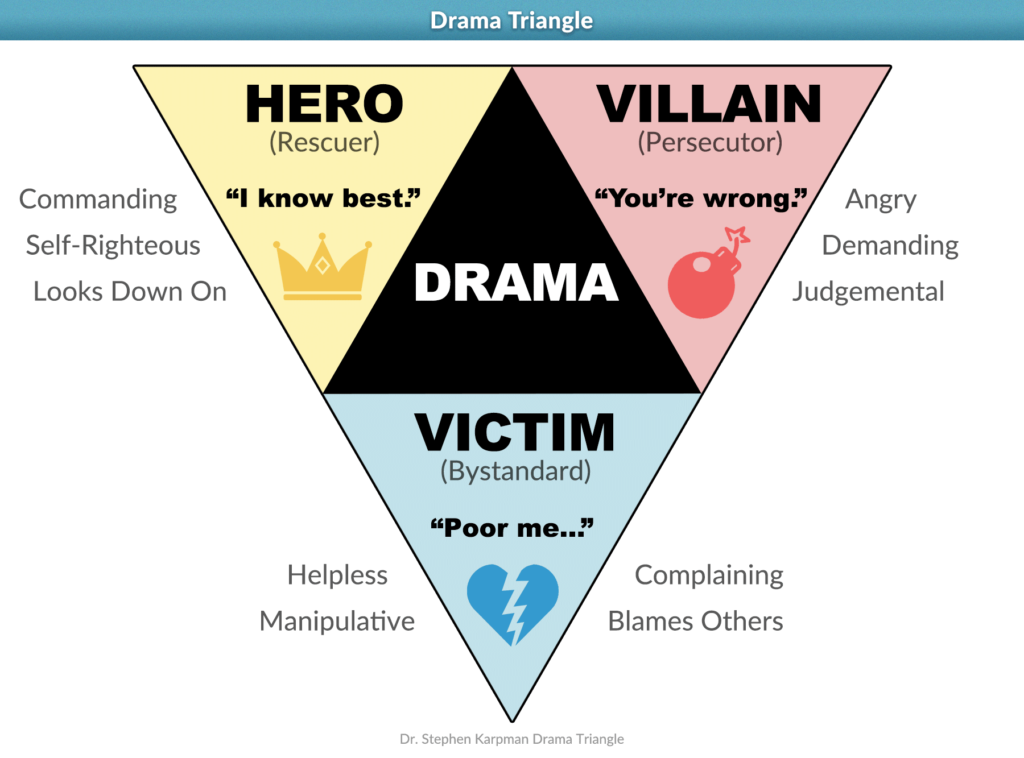In 1968, psychiatrist Stephen Karpman modeled what he called the Drama Triangle. With this, he illustrated dysfunctional mindsets that can derail social interactions. The three roles defined in this model are the rescuer (hero), persecutor (villain), and victim.

This is another view of the lies we tell ourselves. Since the dawn of history, we’ve loved stories. We entertain ourselves with fiction and non-fiction, dramas and comedies. Whether true or not, our imaginations search for these hero, villain, and victim storylines in our own lives – potentially to our detriment.
Sabotage by Projecting on Others
Things are seldom as dramatic as we see in books and movies, but some pieces align with real life from time to time. Occasionally we experience the angel who saves us, or we get to relish in satisfaction when the bad guy falls.
We end up projecting these roles based on what we THINK we should expect from others. Not often do we challenge our own assumptions or verify by asking the other party why they are acting the way they are. We avoid tough conversations that could otherwise lead to a true understanding of someone else’s viewpoint.
Our minds incorrectly associate brief snapshots of a role fulfilled as confirmation of our beliefs. However, people are multi-faceted and unlikely to always fill the same role we have attributed to them. We are complex creatures, and thinking we can understand without verifying is sabotage.
The Hero Role
In Karpman’s original examples he states that the rescuer role uses the line, “Let me help you.” However, he goes on to talk about how it can backfire. This role may remind you of the “I’m the Main Character” trope in modern memery [coining a new phrase here] – even the mental health industry references it.
When you label yourself as the hero in your story, then you run the risk of unfairly naming a villain so that you can:
- feel good about yourself
- always be considered “right”
- assume others are incapable
- receive most of the credit
If you label someone else as the hero in your story you avoid the responsibility of taking ownership yourself. You’ll wait for someone else to swoop in to save the day, but perhaps that day will never come. This is not good either.
The Villain Role
“It’s all your fault,” is the line that Karpman attributes to the persecutor role. Words associated with this might be controlling, critical, rigid, or even angry.
When someone fills this role in your mental story, they tend to be an authoritative individual, deemed superior in position but not necessarily intellect. This is a role that most people don’t assign themselves. If you are creating this role for someone else, it would be to:
- attack someone else
- avoid taking any blame yourself
- gain favor with peers and subordinates
- express pessimism (a safe way to always be right)
It is helpful to understand that the person you label a villain probably thinks of themselves as a hero or a victim. If they have a different goal or viewpoint, perhaps you are aiming at different targets. You can try to find a mutual North Star Goal.
The Victim Role
Karpman portrayed the victim role as saying, “Poor me!” Often viewed as helpless, avoiding risk, and incapable of affecting change (usually with multiple lackluster attempts). The victim will call out a specific villain and is likely waiting for a hero to arrive.
Most people don’t attribute this role to themselves. It’s not a desirable role and it’s a tough pill to swallow when you realize you are living in it. You might notice it in other lies we tell ourselves like the “us versus them” storyline. Here are some phrases you may hear from someone playing the victim:
- They would never agree to it.
- I’ve tried and tried, but it doesn’t work here.
- That is above my pay grade.
- Someone else is responsible for taking care of that.
Assigning this role to others can show a lack of confidence in them, even to the point of disdain toward them. You recognize a lack of intentionality with them. You don’t consider yourself part of that crowd, but you also aren’t willing to step up to be their savior.
Redemption Through Truth and Transparency
If you’ve been paying attention, you’ll notice that none of these roles are good ones. A hero is egotistical and searching for praise. The villain is likely fabricated or misunderstood. Victims are weak and disorganized.
Are you any of those? Not likely. There are probably times when you fill one of the roles for a season, but no one should be pigeonholed to a role. Most of us experience situational uncertainty. We have good days. We have bad days. And that’s the truth. Our actions vary based on the circumstances. We’re all imperfect. We’re all emotional beings.
These comfortable stories fill in the gaps in our understanding and our imaginations go off the rails. It’s the easy way out, but it is unhelpful.
An unending search for transparency is the only solution. You should regularly step back and reflect, spotting when your mind is running wild with a hero-villain-victim story – but recognition is not enough. You’ll still need to push yourself (and others) to have the tough conversation required to align with others. It takes time to ask questions, consider the responses, and properly debate toward consensus.
Start with Optimism
What’s called out in this article are three very pessimistic views of relationships. There is little good to be found by labeling people in your life as described in this model. But Stephen Karpman created it because we do it time and time again!
In my experience, most people (not all) view themselves as inherently “good.” Most people hope for win-win scenarios. There are times when we happily label ourselves as difficult or mean. Sure. But this normally happens after these stories have run their course in our mind and we feel like our actions are a response to someone else being terrible. We just spiral downhill.
Don’t sabotage your team with these stories. My personal principle is that, until proven otherwise, we should start with believing each person wants others to succeed. Don’t assume you know why someone has said something, instead ask them specifically so they can explain it. Start with trust. Push for transparency.
Mirroring is a Simple Method to Use
The book, “Never Split the Difference” by Chris Voss and Tahl Raz, suggests that mirroring people’s words is an easy way to get them to elaborate.
I love this approach! It aligns with my belief that we should be optimistic about someone’s intent and then verify that we understand. Best of all, mirroring is super-easy!
When you are surprised by something said to you, try repeating the words back to the other person. Example:
- Presumed Villain: “I need this by tomorrow, and you haven’t even started on it!”
- You: “You need this by tomorrow?”
- Presumed Villain: “Yes! I’m desperate here!”
- You: “Desperate?”
- Presumed Villain: “Look, it doesn’t have to be perfect, I know this is last minute. What I really need for tomorrow is…”
Can you see how an intense situation is diffused by simple mirroring? The book has other strong suggestions too, I highly recommend reading it.
Conclusion
I hope the Karpman Drama Triangle helps you recognize stories that may be sabotaging you or your team. I’ve shared suggestions on how to fight our natural tendencies by maintaining faith in others and driving for transparency. Give mirroring a try as a quick and easy step toward that goal.
……
If you are looking for a hero partner to fight your villainous competition, reach out to your Perficient account manager or use our contact form to begin a conversation.

